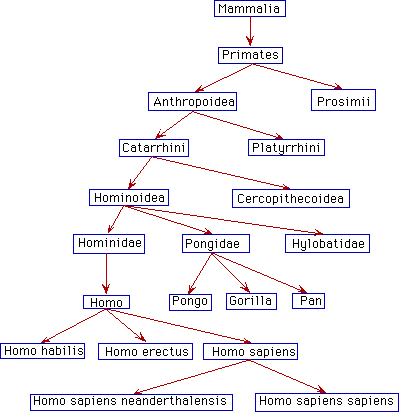Classification
The following list shows where the various monkey families (bolded) are placed in the classification of living (extant) primates. ORDER PRIMATES Suborder Strepsirrhini: non-tarsier prosimians Suborder Haplorhini: tarsiers, monkeys, and apes Infraorder Tarsiiformes Family Tarsiidae: tarsiers Infraorder Simiiformes: simians Parvorder Platyrrhini: New World monkeys Family Callitrichidae: marmosets and tamarins (42 species) Family Cebidae: capuchins and squirrel monkeys (14 species) Family Aotidae: night monkeys (11 species) Family Pitheciidae: titis, sakis, and uakaris (41 species) Family Atelidae: howler, spider, and woolly monkeys (24 species) Parvorder Catarrhini Superfamily Cercopithecoidea Family Cercopithecidae: Old World monkeys (135 species) Superfamily Hominoidea: apes Family Hylobatidae: gibbons ("lesser apes") (15 species) Family Hominidae: great apes including humans (7 species) In common cladistic usage, a monophyletic group is a taxon (group of organisms) which forms a clade, meaning that it consists of a species and all its descendants. The term is synonymous with the uncommon term holophyly. Monophyletic groups a

e typically characterized by shared derived characteristics (synapomorphies). Monophyly is contrasted with the terms paraphyly and polyphyly, which are most easily understood from the second diagram in this article. In current usage, a paraphyletic group consists of all of the descendants of a possibly hypothetical closest common ancestor minus one or more monophyletic groups (most usually one). A paraphyletic group is thus 'nearly' monophyletic (consistent with the meaning of the prefix 'para', namely 'near' or 'alongside'.) A polyphyletic group is any group other than a monophyletic group or a paraphyletic group, which like a paraphyletic group contains only some of the descendants of their closest common ancestor, but unlike a paraphyletic group is not characterized by the missing descendants forming one (or more) monophyletic groups. These definitions have taken some time to be accepted. When the cladistic school of thought became mainstream in the 1960s, several alternative definitions were in use. Indeed, taxonomists sometimes used terms without defining them, leading to confusion in the early literature, a confusion which persists.